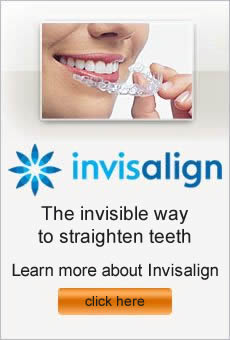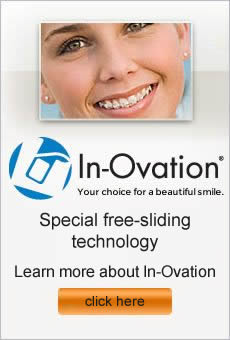When you get braces on your teeth, chances are you want to get rid of them as soon as possible so you can start enjoying your brand new smile. One innovative way to speed up the orthodontics process is AcceleDent Optima, a safe and simple appliance used daily that has been proven to accelerate the effectiveness of braces.
AcceleDent Optima is a comfortable, light, hands-free dental appliance that uses vibrations to hasten tooth movement while wearing braces. The device has been approved by the FDA and its patented SoftPulse Technology has been proven safe and reliable in clinical trials. Your braces guide your teeth in movement into the correct positions, and AcceleDent Optima’s gentle micropulses enhance the movement.
Using AcceleDent Aura is easy. Just insert the mouthpiece, which has been properly fitted around your braces by your orthodontist, and turn on the Activator. Apply just enough bite pressure to allow the device to stay in place without needing to use your hands. It is recommended that patients wear the AcceleDent Optima device for a continuous 20 minutes every day to achieve optimum results.
Research indicates teeth move up to 50 percent faster than without using AcceleDent Optima. This means that the duration of your orthodontic treatment may lessen, which just about every patient is happy to hear! The device works in conjunction with most types of orthodontics. It is only available by prescription through your orthodontist, and it can be used to help patients of all ages reach their smile goals faster.
If you are wearing braces and would like to see if you can get them off sooner than anticipated, ask Sherman Oaks orthodontist Dr. Fotovat about AcceleDent Optima to learn if it’s an option for you. Chances are you’ll be showing off your great new smile in no time with the help of this state-of-the-art tool.
People have desired straight, attractive smiles throughout history, but the ways of achieving the perfect smile has changed over the years. There are lots of choices available when considering orthodontic treatment, thanks to many advancements in technology. There are options to meet the needs of all ages, budgets, lifestyles and goals.
One of the latest innovations is Invisalign clear plastic aligners. These removable, invisible trays straighten teeth gently without all the hassles associated with traditional braces. Invisalign is especially popular among adults who seek to improve their smiles without being embarrassed during treatment.
Self-litigating braces do not have uncomfortable brackets and wires like traditional braces. This system uses a free-sliding technology that moves teeth without much discomfort and in a faster treatment time than other choices.
Lingual braces provide an alternative that fits on the back side of teeth, on the side where your tongue is. Not only are lingual braces unseen to others, they also are popular for patients who play wind instruments or participate in contact sports because they are comfortable and less dangerous.
Some patients are content going with traditional braces, a proven and predictable method of correcting smiles. Many orthodontists now use nickel-titanium wires that are more gentle and durable than previous types of wire.
If you are considering orthodontic treatment, ask a professional about the options available that will be successful for you. Orthodontic treatment is now considered a very customized course of action and can be designed to meet your specific needs. Advanced technology even allows some orthodontists to show patients what their smiles will likely look like at the end of the treatment process.
There’s no reason to go through life unhappy with your smile. Seek the help of a skilled orthodontist who can provide you with the most up-to-date treatment available.
Sometimes traditional orthodontics such as braces aren’t enough to fully correct smiles. When a patient’s jaws don’t line up as they should and a proper bite can’t be achieved, oral surgery might be advised in addition to braces. Surgical orthodontics, or orthognathic surgery, is used to treat severe cases of jaw abnormalities in order to improve the ability to eat, speak and breathe as well as aid facial appearance.
Orthodontists may recommend surgical orthodontics for adult patients who have completed jaw growth, usually between ages 16 and 18. All jaw growth must be completed before surgery will be considered. However, traditional braces or Invisalign clear plastic aligners will likely be started one to two years prior to surgery. Since moving the jaw also involves moving the teeth, braces and surgery are always used together to complete treatment.
During the period of wearing braces, normal adjustments or changes in the series of Invisalign aligners will occur. Teeth will move with treatment, although the bite and jaw alignment may not be able to correct. Once orthognathic surgery is performed, the teeth and jaw will then align properly. The orthodontist and oral surgeon will work closely together to ensure success.
An oral surgeon performs the procedure, which may take several hours, in a hospital. The lower jaw, the upper jaw, or both may receive correction. Bone might be added or removed to help with alignment and stability, and other facial bones may even be repositioned. Recovery from surgery takes up to two weeks, and then the orthodontist will use the braces to finalize the bite and teeth positioning. Orthodontic treatment is usually complete within 6 to 12 months after surgery, and then a retainer will be worn to protect the smile.
Patients who undergo orthognathic surgery in additional to braces may feel like it’s been a long road, but the results are a beautiful smile and facial appearance that likely wouldn’t have been possible without surgery. This form of treatment may seem extreme, but it can improve patients’ lives in many ways.
Just about everyone knows the orthodontist is the type of doctor who gives patients braces on their teeth. But what exactly causes patients to seek the help of an orthodontist? Dentists focus on oral health by providing preventive care and restorative treatment, while orthodontists focus mainly on repositioning and aligning the teeth and jaw. If you have concerns about the appearance of your smile related to your teeth and jaw, a visit to an orthodontist will help ensure that your issues will be properly addressed.
Teeth that are crooked, overcrowded, gapped or otherwise badly positioned is an obvious reason that many people head to the orthodontist. The technical word for crooked teeth is maloclussion, and this problem usually shows up around age 7 when children have a combination of baby and permanent teeth. Crooked teeth can be straightened with orthodontic treatment, which is a good idea to avoid badly positioned teeth causing gum disease or uneven wear on your teeth.
Another reason to see an orthodontist is an underbite, which occurs when the upper teeth are overlapped by the lower teeth. This is often a result of genetics, thumb sucking, prolonged pacifier use or bottle feeding. Braces can be applied to correct underbites.
In a similar category as underbites, patients also seek treatment for overbites, when the bottom teeth are overlapped by the top ones. This is a more common condition and can be caused by similar culprits as underbites. Orthodontic care can correct overbites, although severe cases may require surgery or extraction of some teeth.
Undergoing orthodontic treatment has some added benefits that you might not realize. Correcting spacing issues allows better overall dental hygiene because it’s easier and more efficient to clean properly spaced teeth. Better tooth positioning also promotes more even wear among the teeth, so that certain teeth aren’t subjected to extra biting force. Another outstanding benefit is improved self-esteem because you’ll be proud of your new smile. Adults and young people alike can enjoy a whole new outlook on life with their straight, beautiful smiles.
An innovative approach to straightening teeth can be found with Invisalign. Treatment involves wearing a series of clear plastic aligners to gradually move teeth into better positions. The process is available to both teens and adults, but the unique needs of teenagers are addressed with Invisalign Teen.
Young adults today live very active lifestyles. School, sports, friends, dating and more all add up to very little time or patience for dealing with traditional orthodontics. Invisalign corrects smiles without bothersome metal brackets and wires. Instead, teens are able to go through their daily routines with little impacts during the process of improving their smiles.
Invisalign offers numerous benefits. The removable aligners allow for normal brushing and flossing, eating without diet restrictions, and the ability to skip wearing them for special occasions. Invisalign creates little to no irritation or discomfort, and the invisible quality of the aligners means keeping a confident smile during treatment.
Invisalign Teen is very similar to the adult version of the product, but it has some features that appeal especially to the younger audience. These include:
- Small blue dot indicators on each aligner that gauges wear time. The dots fade after about two weeks of wear, indicating it’s time for a new aligner. This helps dentists know whether or not teens are adhering to the wearing guidelines when two weeks passes but the dot is not gone; more consistent use is then advised.
- Eruption tabs are present to compensate for a mouth that does not yet have all of the permanent teeth fully erupted. Spaces are left in the aligners for adult teeth to form, actually helping to guide new teeth into good positions as they erupt.
- Since teens are known to lose things often, up to six replacement aligners are available for free. This reduces the stress and expense over misplaced aligners.
- With sports or playing musical instruments a common part of teen years, Invisalign doesn’t hold the patient back from enjoying those activities. There are less risks for mouth injury or appliance damage than with traditional braces.
Teens find Invisalign to be a very appealing alternative for smile correction. Ask your dentist about it for your teen today!
In the advanced world of orthodontics, new technologies have joined traditional braces on the stage for improving smiles. If you’re considering orthodontics, it’s smart to investigate the different options to see what’s right for you. One of the choices is called In-Ovation metal braces.
In-Ovation is a cutting-edge system that gives you the smile you’ve dreamed of having. In a grouping called self-litigating braces, they avoid the use of uncomfortable ties or elastics. In-Ovation metal braces use metal brackets, and they have a special clip that holds the wire to the bracket instead of using a rubber tie like traditional braces. The clip enables the archwire to guide the teeth into better positions. This metal-to-metal characteristic reduces friction with tooth movement, allowing for faster movement with less discomfort.
Because there are few wires and they don’t require adjusting like traditional braces, there are fewer appointments with the orthodontist. Patients only need to go into the office every 8 to 14 weeks, a great benefit for those with busy schedules. There are less demands for missing school or work due to braces adjustments.
Many patients also appreciate the look of In-Ovation metal braces. They have a lower profile than other self-litigating options. Not only does that mean they look better in your smile during treatment, you also eliminate the common problems associated with other braces of keeping them clean. They are easier to clean around and these braces produce less plaque buildup.
With faster results than traditional orthodontics, most patients can expect to complete treatment with In-Ovation metal braces in less than eighteen months. Also, this technology doesn’t just focus on straightening the teeth; your orthodontist also can achieve optimum facial proportion during the final phase of treatment. You’ll be thrilled with your whole new look by the end of treatment.
A healthy, attractive smile has never been simpler or less painful. The unique design of In-Ovation metal braces uses a free-sliding technology that places very little pressure on your teeth. Faster, more comfortable treatment is within your reach if you choose In-Ovation metal braces.
Dr. Fotovat treats patients from Sherman Oaks and the surround area with In-Ovation metal braces. Contact our office today to schedule a consultation.



